Supplemental feed is one of the big expenses in cow-calf operations; so sharp decisions are needed for development of an economical but effective nutrition program.
Decision no. 1 – Production objective
The first decision is expressed in design of a program objective that clearly defines desired results of the cattle enterprise. Ted McCollum III, Ph.D., Texas A&M AgriLife Extension service, suggests the following: “Under current environmental and economic constraints, obtain the highest achievable pregnancy rate in the shortest time possible.”
Decision no. 2 – Available forage
Successful producers build their animal nutrition plan around a good pasture system and balance grazing with forage supply. To maintain this balance, the manager must have the ability to measure amounts of available forage.
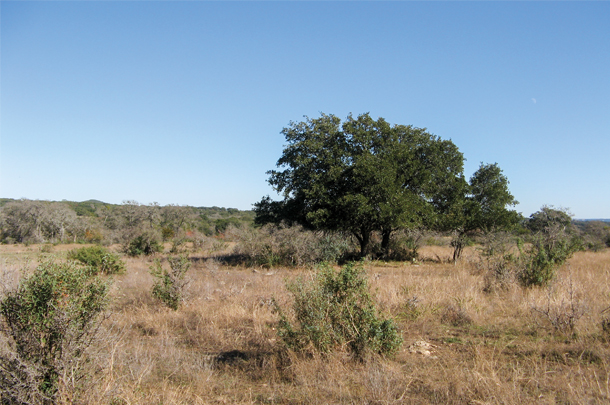
Although most producers understand the importance of assessing production for livestock gain, few invest the time necessary to clip and weigh vegetation, within and across seasons, in order to build a long-term database for their pastures.
Recognizing the need for simplified tools that allow rapid estimation of forage availability, range managers developed grazing sticks imprinted with information for use in managing a grazing plan.
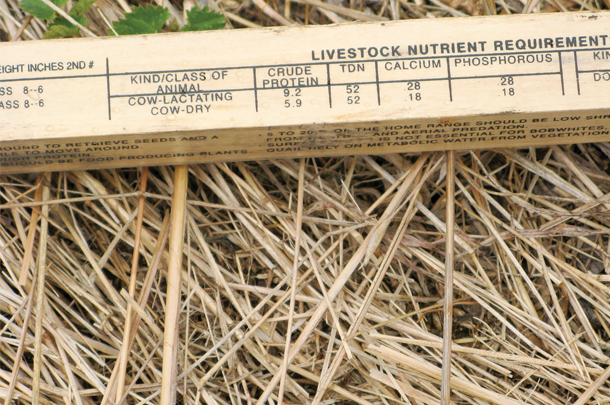
“The grazing stick is designed to measure average leaf height of the vegetation in the grassland by providing a simple yard-stick style ruler on one side,” says Pete Bauman, Ph.D., South Dakota State University Extension. “For every inch of growth, the grazing stick estimates pounds of dry plant material that is available.
“Take several height measurements and then calculate the average,” Bauman recommends. “Then multiply the average height from the measurements by the average pounds per inch (Table 1) to obtain the average pounds per acre value for the pasture.
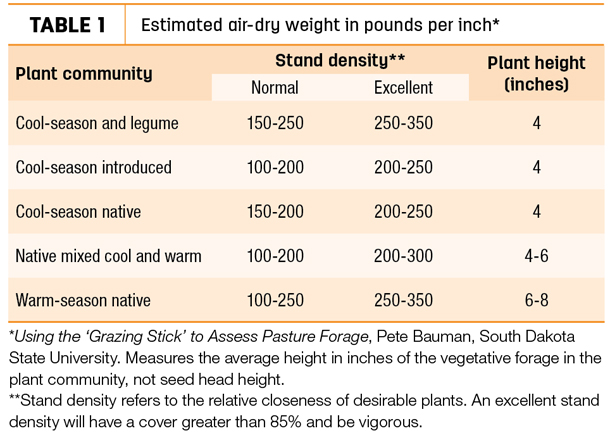
“A good rule of thumb is to take grazing stick measurements at no less than 15 to 20 locations within a grassland area. Areas where measurements are taken should be a fair representation of overall vegetation.
Once forage estimates are obtained, simple math printed on the grazing stick can be used to determine herd size, stocking rates and available grazing days.
“Grass production can be assessed at any time to determine stocking rates or grazing days within a rotational grazing system, and should be measured prior to moving livestock to the next pasture,” Bauman says.
Forage nutritive value
Amount of available forage determines number of cattle that can be grazed on a pasture, whereas forage nutritive value indicates amount of supplement required to meet animal needs. The most economical nutritional plan is to manage pastures for optimum nutritive value so minimum amounts of supplement are purchased.
Regular and timely analyses of forage are required to determine whether vegetation meets daily nutritional requirements of the animals, especially since forage plant characteristics change with maturity. Nutrient evaluation of forage is based on the plant’s content of protein, phosphorus, energy and carotene (vitamin A).
“Protein is calculated from the amount of nitrogen contained in plants,” says Rachel Frost, Ph.D., Montana State University Extension. “Grasses decline in digestible protein rapidly as they mature. Nitrogen is moved by the grass plant from aboveground parts available to the grazing animal to storage organs below the ground as its current year’s growth matures.
“Phosphorus, a macromineral, is often limiting in range forage plants. Grasses are low in phosphorus soon after they form seed. Amount of phosphorus in plants can fluctuate depending on the amount in soil. Soils high in phosphorus will allow plants to contain more phosphorus than where soils are limited in the mineral content.
“Energy values of forage are commonly reported as total digestible nutrients (TDN) or digestible energy (DE),” continues Frost.
“Grasses are generally considered good sources of energy primarily because of their high content of cellulose. In very mature grasses however, digestibility will be low enough to reduce intake and thereby reduce total energy intake. Digestibility is the proportion of a dietary nutrient available for animal metabolism and indirectly tells us something about intake. As digestibility goes down, intake may also go down.”
Vitamin A content in forages varies with season of year and rapidly disintegrates as plant leaves and stems desiccate. Laboratory analyses of forage nutrient content are invaluable for sharpening decisions pertaining to the animal nutrition program.
Cattle physiological status
One of the required exercises in designing an animal nutrition plan is to match available forage and its nutritive content with nutrient requirements of the cow based on her physiological status during different times of the year.
This procedure will highlight a possible opportunity to change a reproduction schedule so the highest animal nutrient requirements occur when quantity and quality of forage is the highest. The exercise also defines when and how much supplement needs to be fed.
“Younger cows are normally smaller and will have a need for higher energy and protein than older animals,” says Milton Orr, University of Tennessee Extension.
“This is due to need of younger cows for nutrients used for growth and development of bone and muscle tissue and deposition of fat. As lactation begins, requirement for energy and protein escalates. In comparison, pregnant cows that are no longer lactating have a need for nutrients to be used for fetal growth, but those will be much less than the requirements for lactation."
"Cows that have a greater genetic potential for milk production will also have an increased need for nutrients. Environmental conditions such as temperature and wind chill also affect amount of nutrients needed as more nutrients are used for keeping the animal warm.”
Cattle size
“Cow weight drives intake of forages and feedstuffs,” says Matt Hersom, Ph.D., University of Florida – Institute of Food and Agricultural Sciences Extension. “Heavier cows normally consume more feed than lighter animals. Through feed intake, cows consume the required energy, protein, fats, vitamins and minerals required for maintenance and production.
Regardless of the time of year, differences in bodyweight are manifested through differences in feed intake.
“Producers that don’t routinely collect weight data on their herd often underestimate actual cow weights. It seems to be a pervasive assessment that most cows weigh, or at least the herd cow weight average is, 1,000 pounds."
"A more correct assessment of the herd cow weight would probably reveal a much smaller proportion of the cows at or near the 1,000-pound benchmark and a greater proportion of the cow herd with weight greater than 1,000 pounds.”
Nutritional decisions can be sharpened by actually weighing cows periodically rather than guessing at their weights.
Climate
“Most beef producers understand that when weather gets colder their cows need more energy to maintain their body condition,” says Warren Rusche, Ph.D., South Dakota State University. “When considering cold stress, we need to factor in both actual temperature and wind speed to determine effective temperature (wind chill).
Data in Table 2 shows that wind speed can dramatically lower effective temperature experienced by cattle.
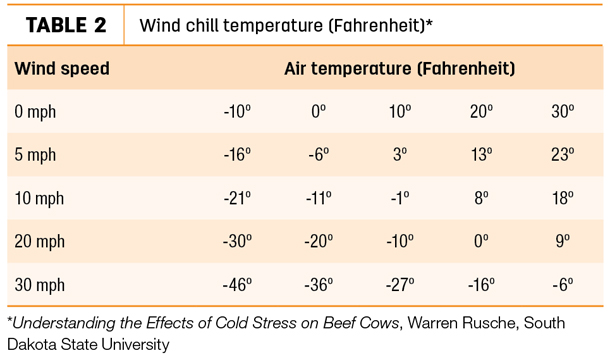
“Point of cold stress, or lower critical temperature, depends largely on amount of insulation provided by the hair coat. As shown in Table 3, insulation value changes are dependent on thickness of hair coat and whether it is dry or wet.
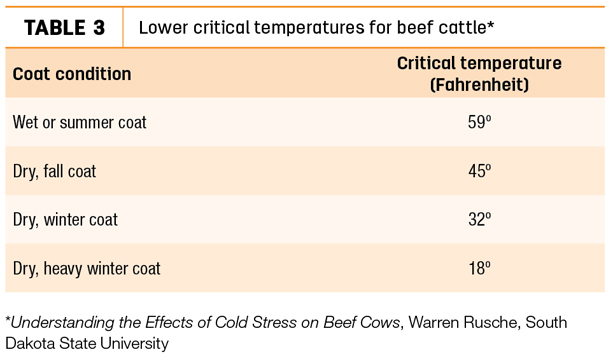
“As a general rule, for every degree that effective temperature is below the lower critical temperature, the cow’s energy needs increase by 1 percent,” continues Rusche. “For instance, if effective temperature is 17ºF degrees, the energy needs of a cow with a dry winter coat are about 15 percent higher than they would be under more moderate conditions. Energy requirement increases to about 40 percent higher under those conditions if the hair coat is completely wet or matted down with mud.”
Some observed changes in intake based on temperature are shown in Table 4.
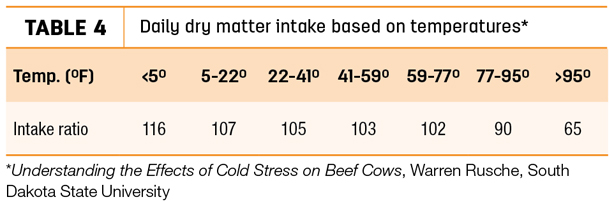
Beef cattle nutrition decisions in the nutrition plan can be sharpened by measuring and studying factors that influence feed intake and nutrient requirements. ![]()
PHOTO 1: A cow’s physiological status plays a big part in her nutritional requirements.
PHOTO 2: Available forage is the basis from which a nutrition plan should be written.
PHOTO 3: The grazing stick has imprinted information that helps design a grazing plan. Photos by Robert Fears.

-
Robert Fears
- Freelance Writer
- Georgetown, Texas
- Email Robert Fears







